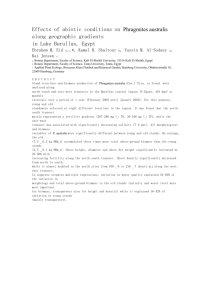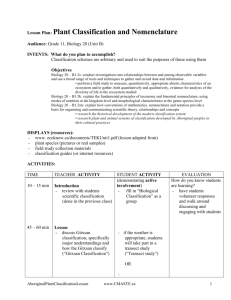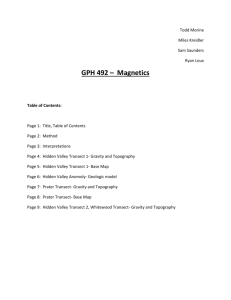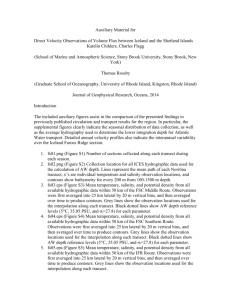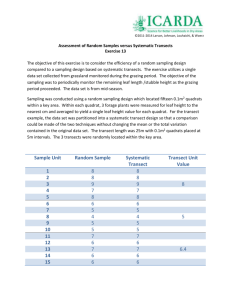Appendix 1(MS Word File)
advertisement
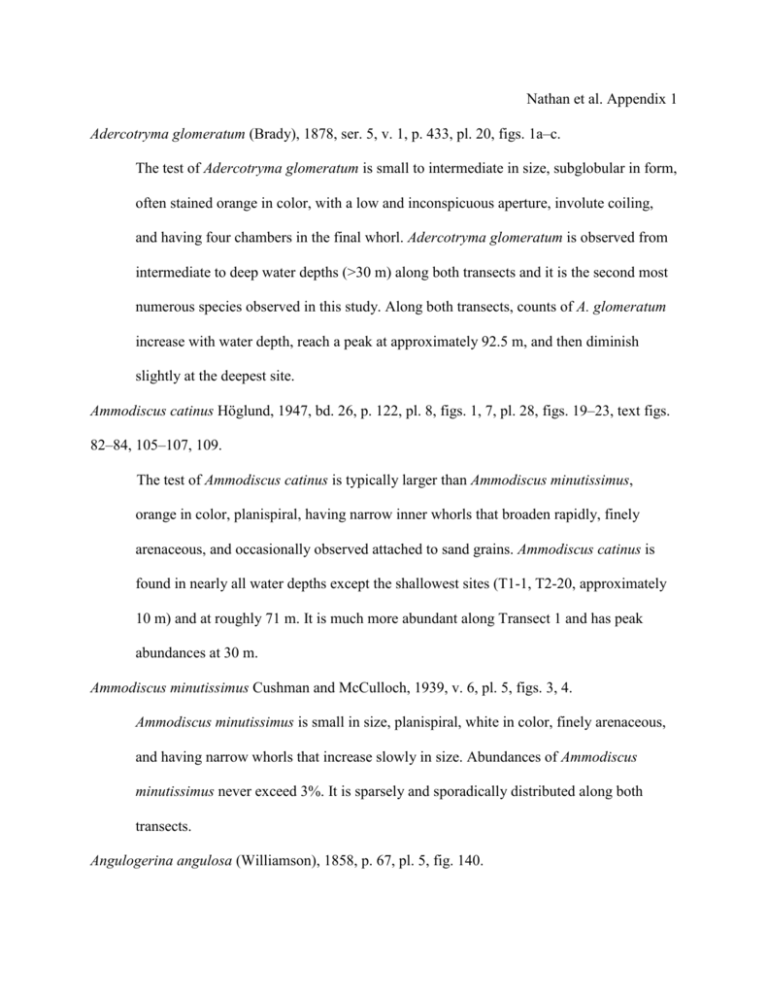
Nathan et al. Appendix 1 Adercotryma glomeratum (Brady), 1878, ser. 5, v. 1, p. 433, pl. 20, figs. 1a–c. The test of Adercotryma glomeratum is small to intermediate in size, subglobular in form, often stained orange in color, with a low and inconspicuous aperture, involute coiling, and having four chambers in the final whorl. Adercotryma glomeratum is observed from intermediate to deep water depths (>30 m) along both transects and it is the second most numerous species observed in this study. Along both transects, counts of A. glomeratum increase with water depth, reach a peak at approximately 92.5 m, and then diminish slightly at the deepest site. Ammodiscus catinus Höglund, 1947, bd. 26, p. 122, pl. 8, figs. 1, 7, pl. 28, figs. 19–23, text figs. 82–84, 105–107, 109. The test of Ammodiscus catinus is typically larger than Ammodiscus minutissimus, orange in color, planispiral, having narrow inner whorls that broaden rapidly, finely arenaceous, and occasionally observed attached to sand grains. Ammodiscus catinus is found in nearly all water depths except the shallowest sites (T1-1, T2-20, approximately 10 m) and at roughly 71 m. It is much more abundant along Transect 1 and has peak abundances at 30 m. Ammodiscus minutissimus Cushman and McCulloch, 1939, v. 6, pl. 5, figs. 3, 4. Ammodiscus minutissimus is small in size, planispiral, white in color, finely arenaceous, and having narrow whorls that increase slowly in size. Abundances of Ammodiscus minutissimus never exceed 3%. It is sparsely and sporadically distributed along both transects. Angulogerina angulosa (Williamson), 1858, p. 67, pl. 5, fig. 140. Astrononion stellatum Cushman and Edwards, 1937, v. 13, pt. 1, pl. 3, figs. 9–11. Bolivina pseudoplicata Heron-Allen and Earland, 1930, v. 50, p. 81, pl. 3, figs. 36–40. Buccella frigida (Cushman), 1922 (1921: 135–147). This species is generally small in size, round in form, biconvex in edge view, and having a low trochospire. Most notable is the star-like pattern of pustules centered over the umbilicus and radiating outward along the ventral sutures. Many tests were glassy in appearance. Along Transect 1 Buccella frigida occurs in samples collected from 9.8–71.5 m water depth , with peak abundance at 50.6 m (10.3% of the assemblage in sample T15). Buccella frigida also occurs at Site T1-10, the deepest site. Buccella frigida is much less abundant along Transect 2, extending 10–50.6 m (at Site T2-15). Bulimina aculeata d’Orbigny, 1826, v. 7, p. 269, n.7. Buliminella complanata (Egger), 1893, (Cl. 2, bd. 18, p. 292, pl. 8, figs. 91, 92. Buliminella elegantissima (d’Orbigny), 1839, v. 5, pt. 5, p. 51, pl. 7, figs. 13, 14. The test of this species is very small in size and delicate, often glassy in appearance. Its form is typical. Occurrences of Buliminella elegantissima are rarely more than a single test in any one sample. Yet, it occurs at enough sites to imply a preferred distribution of shallow to intermediate water depths (<60 m). Bulliminella sp. Bulimina marginata d’Orbigny, 1826, v. 7, p. 269, n. 4, pl. 12, figs. 10–12. The test of Bulimina marginata is small in size. Its chambers overlap those of the previous whorl and are rimmed by spines that are short and sharp. Only a single test of Bulimina marginata was observed in this study. Phleger (1952) and Parker (1952) did not observe the species at localities near our two transects. Cibicides lobatulus (Walker and Jacob), 1798, p. 642, pl. 14, fig. 36. The test of this species can be very large in size. Cibicides lobatulus is characterized by a plano-convex shape, a coarsely perforate spiral side, and an arched, rimmed aperture. Abundances of epifaunal Cibicides lobatulus peak at the shallowest sites along each transect (Sites T1-1, T2-20; approximately 10 m depth) and then rapidly decline with depth. Cibicides lobatulus is much more common along Transect 1 than Transect 2. Cribrostomoides crassimargo (Norman), 1892, pt. 8, p. 17. Test of Cribrostomoides crassimargo can be very large in size, often orange in color, coarsely arenaceous, coarsely finished, with a small, narrow, rimmed aperture that is typical in form. The species was very rare. Cribrostomoides crassimargo is not observed in waters shallower than 30 m. It is more abundant along Transect 1, having peak abundance of 3.2% at 59 m. Cribrostomoides jeffreysii (Williamson), 1858, p. 34, pl. 3, figs. 72, 73. Discorbis columbiensis Cushman, 1925, v. 1, pt. 2, p. 43, pl. 6, figs. 13a–c. Discorbis squamata Phleger and Parker, 1952, pl. 6, figs. 10a–b, 11. Discorbis squamata is observed in only one sample along Transect 1 (29.6 m depth, 5% abundance). Along Transect 2 it occurs at 16.3 m and 19.8 m, with a peak abundance of 6% at 19.8 m. Eggerella advena (Cushman), 1921, (1922), n. 9, p. 141. The test of this species is small in size, triserial, composed of fine sand grains, has a smooth surface, and is typically orange in color. Chambers of the test rapidly inflate to produce a compact cone-like form. Some tests exhibit a gradual chamber inflation that produces a more elongated form of the species. Eggerella advena is found at nearly all depths and sites, making it the most numerous species observed in this study. Eggerella advena comprises 5% to 20% of the assemblage in most samples. It reaches highest abundances at 29.6 m water depth (48.1%) along Transect 1 and at 71.9 m along Transect 2 (25.3%). The species exhibits trace abundances (i.e., <1%) in water depths exceeding 90 m. Elphidium advenum (Cushman) var. margaritaceum Cushman, 1930, Bull. 104, pt. 7, p. 25, pl. 10, fig. 3. The test of Elphidium advenum var. margaritaceum is large, planispiral, round in outline, lacks a plug, has a granulated surface, and a compressed, imperforate margin. The retral sutures (i.e., septal bridges) are the most distinguishing characteristic of E. margaritaceum. Elphidium margaritaceum is very rare (<1%) and occurs in waters <17 m deep. Elphidium margaritaceum was not observed by Phleger (1952) and Parker (1952). Phleger (1952) and Parker (1952) treated E. margaritaceum as a variety of E. advenum while Todd & Low (1981) considered it a separate species. Elphidium excavatum (Terquem), 1930, Bull. 104, pt. 7, p. 20, pl. 7, figs. 10a–b. Tests of Elphidium excavatum are generally large, planispiral, round to slightly ovate in form, lenticular shaped in edge view, and have up to eleven chambers in the final whorl. It has a ventral plug or plugs that distinguish it from Elphidium subarcticum. In this study Elphidium excavatum is the fifth most abundant species. With the exception of sample T1-8 (82.4 m depth), E. excavatum is absent from all samples that were acidic after thawing. This species has greater abundances and a wider range of occurrences along Transect 1 than Transect 2. It is most abundant along Transect 1 in waters less than 20 m. Elphidium excavatum was also found to be very common at the deepest site (Site T1-10, 103 m, >17% abundance). Elphidium subarcticum Cushman, 1944, s.p. 12, p. 27, pl. 3, figs. 34, 35. This species is typically large and planispiral, with a round to oval outline. Larger forms of Elphidium subarcticum have eight to nine chambers while the smallest tests have 4–5 chambers. Tests are opaque but some were found to be green in color, presumably due to the internal sequestering of photosynthetic organisms. It was not unusual to find tests strongly attached to sand grains. To differentiate Elphidium subarcticum from other members of this genus the lack of a ventral plug and the fine granular surface texture was noted. This last characteristic is especially diagnostic along the sutures of the test. Elphidium subarcticum is an epifaunal species that is very common in waters shallower than 30 m, making it the third most numerous species observed in this study. Elphidium subarcticum and E. excavatum account for approximately 15% of all tests observed in this study. Other species of this genus occur in only trace numbers. Elphidium subarcticum is somewhat more abundant along Transect 2 than along Transect 1. For both transects E. subarcticum is absent, or essentially so, deeper than 59 m. Eoeponidella pulchella (Phleger and Parker), 1952, pl. 6, figs. 18a–b, 19, 20) Epistominella vitrea Parker 1953. Epistominella vitrea is a calcareous species that is observed in all samples that had alkaline pH values. It is more abundant in waters that are less than 30 m deep and slightly more abundant along Transect 2 than Transect 1. Fursenkoina fusiformis (Williamson), 1858, p. 64, pl. 5, figs. 129, 130. The test of Fursenkoina fusiformis is small, very delicate and glassy. Its comma-shaped aperture may extend slightly and appear neck-like. Fursenkoina fusiformis has rapidly inflating chambers while its spire can vary from low to high. Fursenkoina fusiformis is relatively rare along both transects and it is found in water depths ranging from 20–59 m. Globobulimina auriculata (Bailey), 1851, v. 2, p. 12, pl. 1, figs. 25–27. In this study tests of Globobulimina auriculata are large, typical in form, often glassy, and delicate. Globobulimina auriculata is most abundant at the deepest station and is rarely observed along transect one (it is absent along transect two). Phleger (1952) and Parker (1952) recorded similar abundances and depth distribution but not at localities analogous to those in this study. Globocassidulina algida (Cushman), 1944, s.p. 12, p. 35, pl. 4, fig. 24 and Globocassidulina islandica (Nørvang), 1945, v. 2, pt. 2, p. 43, text figs. 8a–c. Globocassidulina algida occurs in a wide range of forms with some being gradational with Globocassidulina islandica. One end member of G. algida is distinct in having greatly inflated chambers, resembling a closely packed cluster of grapes. These tests are often glassy in appearance and large in size compared to G. islandica. The opposite end member of G. algida is smaller in size, often opaque and having minimal chamber inflation. To differentiate this latter form of G. algida from G. islandica, we evaluated the position of the aperture with respect to the umbilicus. Tests having an aperture opening towards the margin were identified as G. algida while tests having an aperture opening towards the umbilicus were identified as G. islandica. Tests of G. islandica are typically opaque and smaller in size than those of G. algida. The observed form of G. islandica ranges from smooth to having slightly inflated chambers. Both species are absent from samples that were acidic after thawing. The two species were found in samples collected from water depths less than 59 m deep and are more abundant along Transect 1. Along Transect 1 Globocassidulina islandica abundance peaks at its deepest occurrence (5%, 59 m, Site T1-6). Globocassidulina algida has its peak abundance at Site T1-5 (5%, 50.6 m). Both species are very rare along Transect 2 (with counts ranging from a single test to 1.3%). No tests are observed deeper than 50.6 m on either transect. Globulina gibba d’Orbigny, 1826, v. 7, p. 266, n. 10. Globulina glacialis Cushman and Ozawa, 1930, v. 77, n. 2829, art. 6, p. 71. Glomospira gordialis is rare. It is more common along Transect 1 than Transect 2, although Transect 1 abundances never exceed 4%. The species is absent from the shallowest and deepest sites. Glomospira gordialis (Jones and Parker), 1860, v. 16, p. 304. The coiling of Glomospira gordialis is highly variable, ranging from almost planispiral to globular. The test is orange in color and finely arenaceous. Guttulina lacteal (Walker and Jacob), 1798. Hippocrepina indivisa Parker, 1870, v. 5, p. 176, fig. 2. The complete test of Hippocrepina indivisa is moderate in size but extremely rare. Typically, only the conical terminus is preserved. The single chambered test is finely arenaceous, delicate, orange in color, and has fine creases that are transverse to the long axis. Hippocrepina indivisa is found only in water depths exceeding 50 m. Peak abundances (9% to 10%) occur at depths of approximately 72–82 m along both transects. Lagena clavata (d’Orbigny), 1846. The test of Lagena clavata is elongate, smooth, delicate, and having a distinct neck and apical spine. A single test was observed in 16.3 m water depth at Site T2-19. Phleger (1952) and Parker (1952) did not observe the species. Lagena mollis Cushman, 1944. Lagena mollis is similar to Lagena clavata. However, L. mollis is less swollen and has a finely striate surface. Only two L. mollis tests were observed (at ~50 m depth in Transect 1). Phleger (1952) and Parker (1952) did not report the presence of L. mollis. Lenticulina sp. Miliammina frigida (Phleger and Parker), 1952, pl. 3, figs. 20a–b. Miliammina fusca (Brady), 1870, ser. 4, v. 6, p. 47 (286), pl. 11, figs. 2a–c, 3. Nonionella auricula Heron-Allen and Earland, 1930, v. 50, p. 192, pl. 5, figs. 68–70 Nonionellina labradorica (Dawson), 1860, v. 5, p. 191, fig. 4. Nonionellina labradorica is absent along Transect 2. Along Transect 1 it has a 1% abundance at 59.0 m depth and 9% at 103 m. It is absent across the delta plain and in the acidic samples. Psammosphaera fusca Schulze, 1875, p. 113. Psammosphaera fusca is generally large to very large in size. It is composed of coarse sand grains of varying mineralogy that are widely separated by cement, this gives the test a coarse finish. Typically, the test has a single aperture. Abundances are low and it is observed at intermittent water depths (approximately 20–75 m). Pseudopolymorphina novangliae (Cushman), 1923, Bull. 104, pt. 4, p. 146, pl. 39, figs. 6–8. Pyrgo sp. Quinqueloculina spp. We use a broad species concept for Quinqueloculina spp., grouping together species such as Q. seminula and Q. subrotunda. The tests of species comprising this genus can be very large, oval in form, have a porcelaneous finish, exhibit four chambers on one side of the test, and three on the other side. Specimens are typically white and opaque, but some are nearly transparent. Tests are often complete but some are broken, where the latter are perhaps not recent in age and having been reworked. Quinqueloculina sp. is observed in shallow to intermediate water depths, but more commonly along Transect 2. For both transects abundances peak at ~30 m depth and it is absent in water deeper than 51 m. Quinqueloculina lata Terquem, 1876, p. 82 Quinqueloculina seminula typical (Linné), 1758, ed. 10, p. 786. Reophax arcticus Brady, 1881, ser. 5, v. 8, p. 405, pl. 21, fig. 2 Reophax arcticus is typical in form for the region. The test is small in size, uniserial, and with chambers that are wider than long. The species is very rare along Transect 1. Along Transect 2 it is limited to intermediate water depths, exhibiting peak abundance at 71.9 m. Reophax curtus Cushman, 1920, Bull. 104, pt. 2, p. 8, pl. 2, figs. 2, 3. This species is highly variable in form. Reophax curtus is large, coarsely arenaceous, coarsely finished, and composed of grains having variable mineralogy. Chambers generally increase slowly in size, although this can vary. It was rare to observe more than three chambers in a test. A delicate, neck-like final chamber composed of finer grains was occasionally seen. Fragments of R. curtus tests comprised of a single chamber were differentiated from Saccammina atlantica by observing an opening on the broader end of the fragment. Reophax curtus is found in waters greater than 30 m depth. It is much more prevalent along Transect 2 than Transect 1, with abundances that peak around 65 m and decreasing with increasing depth (i.e., 0.5% at 103 m). Reophax scottii Chaster, 1890–91 (1892), p. 57, pl. 1, fig. 1. Incomplete tests of Reophax scottii (having 4 to 8 chambers) were counted as a whole organism, but this occurred rarely. In general, R. scottii was distinguished from R. gracilis by having more than 10 chambers. Some tests of R. scottii had upwards of 15 chambers. Chambers of R. scottii tend to be nearly as wide as long. By contrast, R. gracilis tends to have chambers that are longer than wide. Based on this criterion, no tests of R. gracilis were considered to be present in this study. Reophax scottii was observed only along Transect 2 in water depths ranging from 10.0–71.9 m. It is least abundant in the shallowest site, reaching a maximum at 50.6 m (Site T2-15), and decreasing in deeper water. Saccammina sp. Saccammina atlantica (Cushman), 1944, s.p. 12, p. 5, pl. 1, fig. 4. Saccammina atlantica is large, coarsely arenaceous, sometimes smoothly finished, and composed of grains having variable mineralogy. The test is teardrop shaped but lacks a distinct neck. The rounded base of the teardrop is closed, permitting S. atlantica to be differentiated from broken tests of R. curtus. Saccammina atlantica is much more abundant along Transect 2. Along Transect 1, S. atlantica has scattered occurrences and appears only at trace levels (<1%). Along Transect 2, S. atlantica first appears deeper than 20 m depth, reaches peak abundance around 42 m (>30%), and then declines to about 1% abundance at 103 m. Saccammina difflugiformis (Brady), 1879, v. 19, p. 51, pl. 4, figs. 3a–b. Saccammina difflugiformis is small in size, has a teardrop shape that often tapers to a distinct neck, somewhat finely arenaceous, and having a smoothly finished surface. Occasionally the test contains large grains that are cemented flush with the surface. Some small tests of S. difflugiformis might be considered as gradational with S. atlantica. Saccammina difflugiformis is rarely observed along Transect 1. It reaches a broad peak in intermediate water depths along Transect 2. Spiroplectammina biformis (Parker and Jones), 1865, v. 155, p. 370, pl. 15, figs. 23, 24. Spiroplectammina biformis is generally small in size, but having a variable number of chambers present after the initial whorl. The test is finely arenaceous and sometimes bent or twisted after the initial whorl. Spiroplectammina biformis is common in intermediate to deep waters along both transects. Abundances of S. biformis increase with depth, peaking at approximately 70 m–80 m before decreasing slightly in deeper waters. Spiroplectammina typica Lacroix, 1931, n. 582, p. 14, fig. 9, n. 591, p. 6, text figs. 2, 3. This species is widely variable in form. Some tests are comprised of a single, uniserial, planispiral whorl. Other tests have a limited number of biserial chambers extending from the initial whorl. The largest tests are compressed and broad in form, having many chambers after the initial whorl. Tests of S. typica tend to be white, have a salt and pepper appearance, and are somewhat coarsely arenaceous for their size. Spiroplectammina typica first appears in waters of intermediate depth, reaching peak abundance at approximately 60 m. Abundances of S. typica then decrease steadily with increasing water depth. Textularia earlandi Parker, 1952, Phleger, 1952 3: 80–89. Textularia torquata Phleger and Parker 1952 (pl. 3, figs. 9–11) The test of Textularia torquata is small, coarsely arenaceous for its size, compressed and often slightly twisted. Textularia torquata is biserial, having a slightly lobulate periphery, with rapidly enlarging chambers that make the apertural end the broadest. Textularia torquata is the fourth most common species observed in this study. It is found in intermediate and deep waters along both transects with abundances peaking around 72– 82 m depth. Trochammina sp. Trochammina advena Cushman, 1922, p. 20, pl. 1, figs. 2–4. Trochammina inflata (Montagu), 1808, p. 81, pl. 18, fig. 3. Trochammina lobata Cushman, 1944, s.p. 12, p. 18, pl. 2, fig. 10. Trochammina lobata is generally large in size, round to ovate in form, constructed of fine to coarse grains, having a smooth finish, and typically orange in color. Trochammina lobata is observed along both transects, near the delta break. The species was slightly more abundant along Transect 1, reaching a maximum abundance of 5% at 59 m depth. Trochammina cf. macrescens (Brady), 1870, ser. 4, v. 6, p. 51, pl. 11, figs. 5a–c. Trochammina quadriloba Höglund, 1948, v. 24, pt. 2, p. 46. Trochammina squamata Parker and Jones, 1865, v. 155, p. 407, pl. 15, figs. 30, 31a–c. Trochammina squamata is observed only along Transect 2. It has a peak in abundance at 20 m depth.



